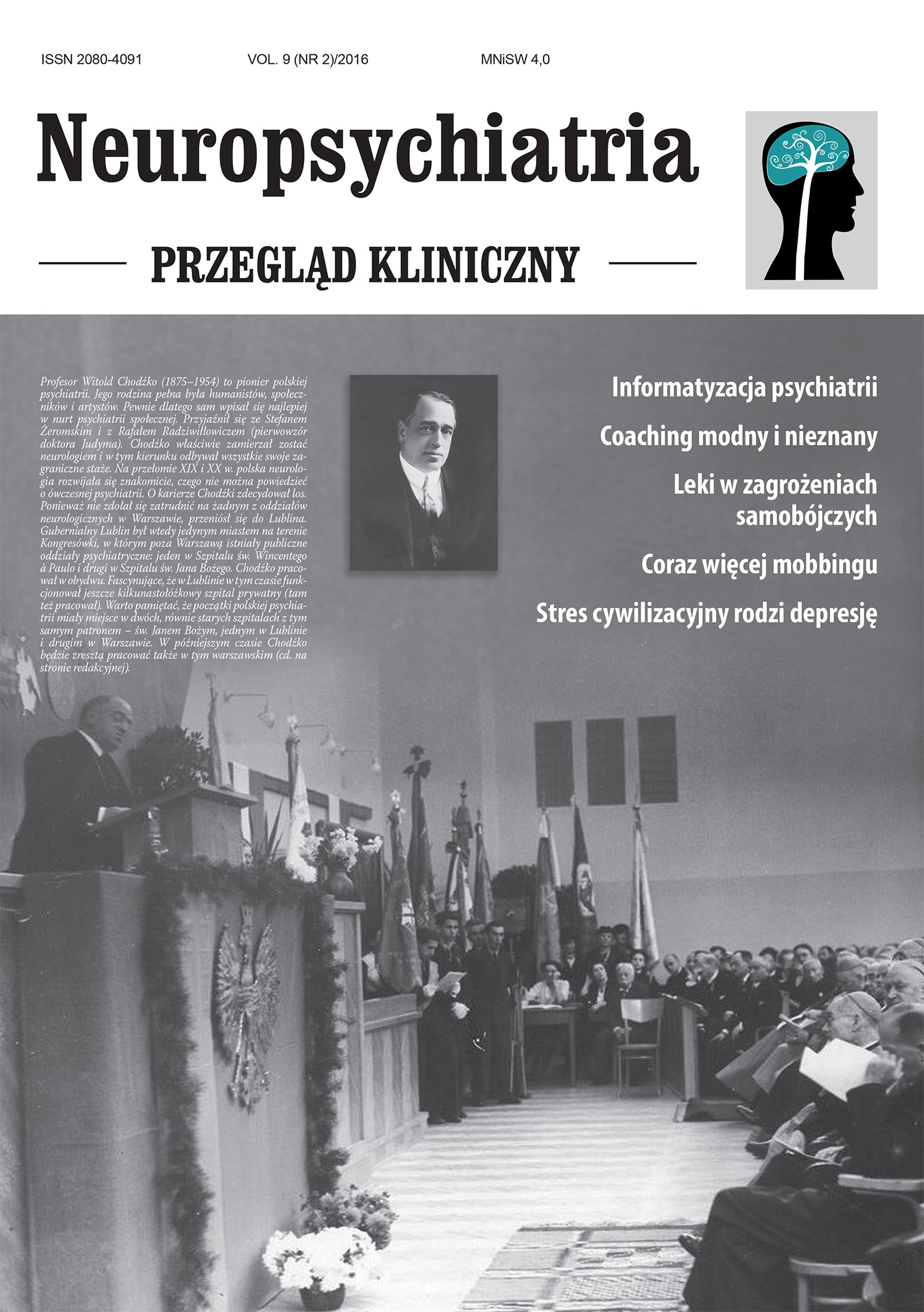Psychopharmacological reduction of suicidal risk Review article
Main Article Content
Abstract
Some medications, like lithium, ketamine, and clozapine, demonstrate clearly benefits in the prevention of suicidal behavior in psychiatric patients. However, the sum of existing studies is generally inconclusive whether all psychotropic drugs are effective to reduce the suicidal risk. All drugs that mediate impulsivity and/or aggression can be potentially useful. Unfortunately, there is only one drug, i.e. clozapine, officially approved for suicidal patients. Ketamine may reduce suicidal ideation independently of a reduction in depressive or anxiety symptoms. Little is known about pharmacotherapy effects on suicidal ideation as distinct result from suicidal behaviors. All atypical antipsychotics seem to reduce the suicidal risk. The most complex properties are related to antidepressants, as there are warnings about the suicidal risk among youngsters, however the risk is ameliorated in most adult and older patients, especially if we use newer antidepressants (e.g. escitalopram) for a long-time treatment.
Article Details

This work is licensed under a Creative Commons Attribution-NonCommercial-NoDerivatives 4.0 International License.
Copyright: © Medical Education sp. z o.o. License allowing third parties to copy and redistribute the material in any medium or format and to remix, transform, and build upon the material, provided the original work is properly cited and states its license.
Address reprint requests to: Medical Education, Marcin Kuźma (marcin.kuzma@mededu.pl)
References
2. Kupfer DJ. DSM-5’s New Approach to Suicide Risk, Behavior. Huffpost Healthy Living.
3. Oquendo MA, Baca-Garcia E. Suicidal behavior disorder as a diagnostic entity in the DSM-5 classification system: advantages outweigh limitations. World Psychiatry 2014; 13(2): 128-130.
4. WHO. World Health Organization. Suicide.
5. Nordentoft M. Prevention of suicide and attempted suicide in Denmark. Epidemiological studies of suicide and intervention studies in selected risk groups. Dan Med Bull 2007; 54(4): 306-369.
6. Szymańczak J. Samobójstwa Polaków. Analizy Biura Analiz Sejmowych 2015; 6(126).
7. Altamura AC, Bassetti R, Bignotti S et al. Clinical variables related to suicide attempts in schizophrenic patients: a retrospective study. Schizophr Res 2003; 60(1): 47-55.
8. Kasckow J, Felmet K, Zisook S. Managing suicide risk in patients with schizophrenia. CNS Drugs 2011; 25(2): 129-143.
9. Angst J, Sellaro R, Angst F. Long-term outcome and mortality of treated versus untreated bipolar and depressed patients: a preliminary report. Int J Psychiatry Clin Pract 1998; 2(2): 115-119.
10. Ohgami H, Terao T, Shiotsuki I et al. Lithium levels in drinking water and risk of suicide. Br J Psychiatry 2009; 194(5): 464-465.
11. Sugawara N, Yasui-Furukori N, Ishii N et al. Lithium in Tap Water and Suicide Mortality in Japan. Int J Environ Res Public Health 2013; 10(11): 6044-6048.
12. Terao T, Ishii N, Shiotsuki I. Lithium in Drinking Water for Dementia and Suicide. Austin J Psychiatry Behav Sci 2014; 1(5): 1022.
13. Baldessarini RJ, Tondo L, Davis P et al. Decreased risk of suicides and attempts during long-term lithium treatment: a meta-analytic review. Bipolar Disord 2006; 8(5 Pt 2): 625-639.
14. Ballard ED, Ionescu DF, Vande Voort JL et al. Improvement in suicidal ideation after ketamine infusion: relationship to reductions in depression and anxiety. J Psychiatr Res 2014; 58: 161-166.
15. Reinstatler L, Youssef NA. Ketamine as a potential treatment for suicidal ideation: a systematic review of the literature. Drugs RD 2015; 15(1): 37-43.
16. Lu CY, Zhang F, Lakoma MD et al. Changes in antidepressant use by young people and suicidal behavior after FDA warnings and media coverage: quasi-experimental study. BMJ 2014; 348: g3596. https://doi.org/10.1136/bmj.g3596.
17. Perroud N, Uher R, Marusic A et al. Suicidal ideation during treatment of depression with escitalopram and nortriptyline in genome-based therapeutic drugs for depression (GENDEP): a clinical trial. BMC Med 2009; 7: 60. https://doi.org/10.1186/1741-7015-7-60.
18. Vinod KY, Hungund BL. Role of the endocannabinoid system in depression and suicide. Trends Pharmacol Sci 2006; 27(10): 539-545.
19. Pedersen MG, Mortensen PB, Norgaard-Pedersen B, Postolache TT. Toxoplasma gondii Infection and Self-directed Violence in Mothers. JAMA Psychiatry 2012; 69(11): 1123-1130.
20. Hawton K, Casañas I, Comabella C. Risk factors for suicide in individuals with depression: a systematic review. J Affect Disord 2013; 147(1-3): 17-28.
21. Neale G, Smith AJ. Self-harm and suicide associated with benzodiazepine usage. Br J Gen Pract 2007; 57(538): 407-408.
22. Hesdorffer DC, Kanner AM. The FDA alert on suicidality and antiepileptic drugs: Fire or false alarm? Epilepsia 2009; 50(5): 978-986.
23. Łoza B, Gryglewicz J. Raport. Narodowy Program Ochrony Zdrowia Psychicznego 2016–2020. Rekomendacje. Fundacja Ius Medicinae, Warszawa 2015.

